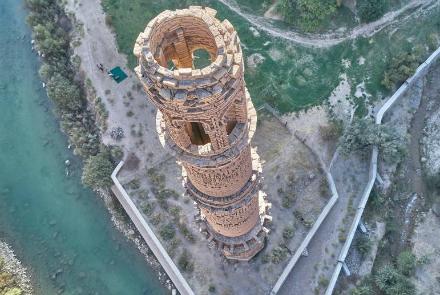A special meeting attended by officials from Ministry of Information and Culture and representatives of the United Nations Educational, Scientific and Cultural Organization (UNESCO) was held in Kabul on Saturday to discuss ways to protect the 900-year-old Minaret of Jam in Afghanistan’s Ghor province – which is on the verge of collapse due to recent flash floods.
The minaret is located in Ghor, around 200 kilometers east of Herat in the west of Afghanistan, at the confluence of the Hari Rud and Jam Rud rivers. The isolated location of the minaret may have prevented the monument from intentional destruction over nearly 900 years.
The minaret is believed to have been built between 1163 and 1203 during the reign of the Ghurid sovereign Ghyias-ud-Din. It has been on the UNESCO List of World Heritage Properties in Danger since 2002.
The minaret is 62 meters high and was built entirely of baked bricks and is famous for its intricate brick, stucco and glazed tile decoration.
Minaret of Jam after the Qutub Minar in New Delhi is the second tallest brick-built minaret in the world.
A number of lames said the Afghan government, especially the Ministry of Information and Culture, and the UNESCO have not paid the required attention to protect the endangered monument in Ghor.
Herat officials, however, said that almost 300 employees were assigned to change the direction of the flood and their mission was successfully accomplished on Saturday.
“Palaces that are not even hundred years old (are being reconstructed), but cultural and historic heritages such a Minaret of Jam which is over 800 years old, unfortunately, have been forgotten and it is an obvious discrimination against the cultural heritage and historical sites of west zone,” Abdul Zahir Tamim, an MP, said.
“The Minaret of Jam’s budget documents should be assessed comprehensively,” Keramuddin Reza Zada, an MP said.
Acting Minister of Information and Culture Hasina Safi said at the meeting that they are working on protection of the minaret.
“It is not easy. It is not just a wall. It is not such an ancient site that we can reconstruct it. It is centuries of Afghanistan’s history,” Safi said.
The Presidential Palace in a statement said that it was decided in the cabinet meeting on Saturday to send a team to Ghor and assess the status of the minaret.
Imran Khan Massoudi, an advisor to the UNESCO office in Kabul, said millions of dollars are needed for protection and maintenance of the minaret.
Massoudi said UNESCO has allocated $2 million for assessing and protection of the minaret.
“At any level you want, UNESCO has an obligation to find experts from any corner of the world. But the order should come from the Ministry of Information and Culture and from the Afghan government. UNESCO alone never can make a decision or can take action,” said Massoudi.


